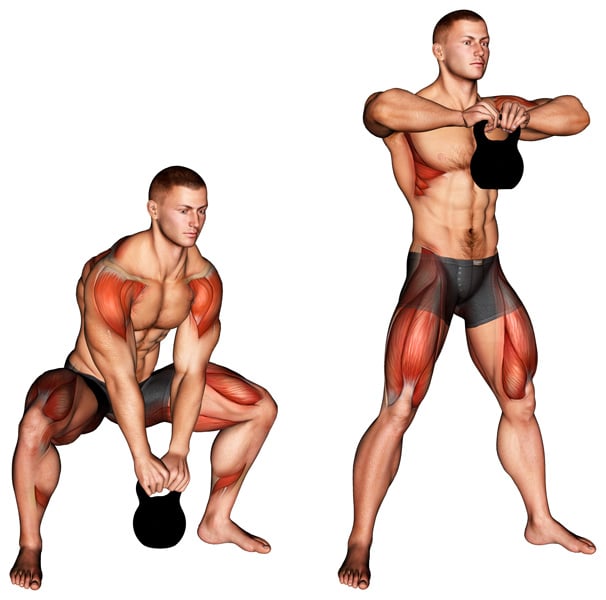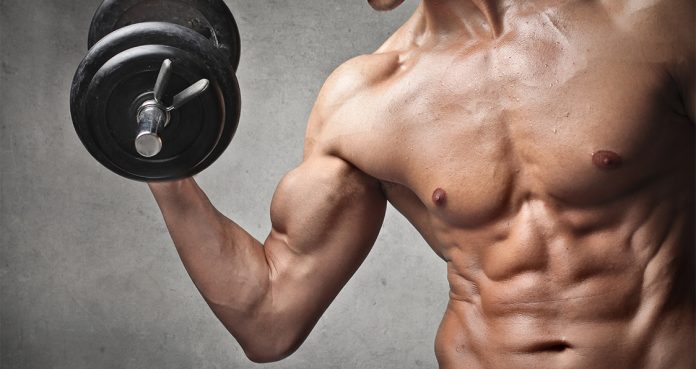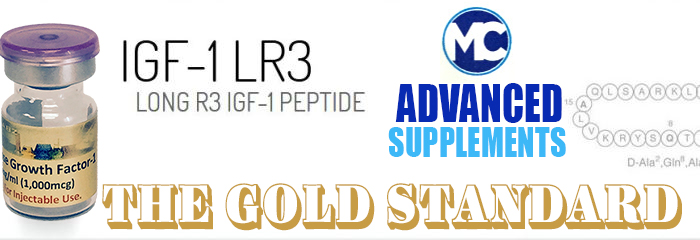Tag: hypertrophy

Kettlebell Sumo High Pull — How To, Variations and Muscles Worked
The kettlebell sumo high pull (or kettlebell sumo deadlift high pull) is a functional exercise that also builds strength and muscle throughout the entire body. It combines a deadlift and upright row, and, therefore isn’t just a simple movement which is why it’s so effective. Consequently, it’s not the best option for beginners to try…

5 Ways To Integrate Powerlifting And Bodybuilding
5 Ways To Integrate Powerlifting And Bodybuilding.
The longstanding relationship between bodybuilding and powerlifting has generally been that of a healthy rivalry. But sometimes oppositional thinking can blind one camp to the benefits of the other.
Recently, powerlifting has become increasingly fashionable in the fitness community, and new athletes are rising who are skilled in both powerlifting and aesthetic training, among them are names like Stan Efferding, and Susan Salazar. The following are some of tips for incorporating powerlifting and bodybuilding.
1. Heavy weights, higher reps
Powerlifters prioritize neurological training, but hypertrophy work (6-15 reps) builds a foundation of actual muscle for that training, which is often neglected by powerlifters. Often the weakest link for powerlifter is not their ability to recruit muscular force, it’s the amount of muscle available for recruitment. Bodybuilders often forget that hard, dense muscle and serious thickness is built with heavy weight. He compares Ronnie Coleman and Phil Heath: one preferred lifting very heavy and the other didn’t. The difference is clear.
2. Exchange Movements
To the powerlifters, it’s important to to balance the body. A more complete muscular system will minimize injury, increase strength and mobility, and allow the body to optimally recruit firing patterns.
To the bodybuilders, include some compound movements. Low bar squats are one of the best hamstring and glute builders out there. Paused bench press gives your chest and triceps a completely different stimulation and leads to thickness and growth because you’re starting from a dead point in a different firing pattern. And things like sumo deadlifts can take a lot of pressure off the precious low back while being phenomenal lower body developers.
3. Exchange Rep Ranges
Most bodybuilders would benefit from occasionally lowering the rep range to 1-3. A more powerful neurological system will always be a driver of muscular gains.For powerlifters he recommends occasional sessions of over 15 reps. Increased blood flow pulls nutrition into the joints and stimulates growth in slow twitch fibers. It will also help powerlifters walk up long staircases without feeling out of breath.
4. Nutrition
For bodybuilders, we recommend increasing carbohydrate intake. Carbs help strength performance and can be added slowly and safely into any diet if monitored properly. If you care about strength performance, you need carbs. Powerlifters, by contrast, should have focus on proper macros. Just because strength is king doesn’t mean donuts don’t hurt. He recommends baseline of 1.2-1.5g of protein, 1.5-4.0g of carbs, and 0.3-0.6g of healthy fat per pound of body weight.
5. Strategic Periodization
If you want to compete in both sports, strategic programming must be employed year round. Obviously, one doesn’t want to be maxing out 4 weeks out from a show and you don’t want to be doing a ton of accessory volume 4 weeks out from a meet. Everything has it’s place in a strategic and balanced program.
What do you think of these 5 Ways To Integrate Powerlifting And Bodybuilding? Let us know in the comments below. Also, be sure to follow Generation Iron on Facebook and Twitter.

Straight Facts: Everything You Need To Know About Muscle Hypertrophy
[embedded content]
Jerry Brainum shares the straight facts on the three key factors involved in muscle hypertrophy – aka muscle growth.
If you are even a casual bodybuilder you have likely heard the term muscle hypertrophy. In simplest terms, muscle hypertrophy is the growth of muscle fibers. It’s a key factor in bodybuilding and sculpting a physique. While any gym goer has likely activated muscle hypertrophy through the act of weightlifting – there is a lot of science behind how this muscle growth actually occurs. Understanding the key factors behind this science can help you optimize your training for better muscle growth. In our latest episode of Straight Facts, Jerry Brainum breaks down everything you need to know about muscle hypertrophy.
So how does one achieve muscle hypertrophy? Resistance exercises, aka weightlifting exercises, are the number one best way to grow muscles. This may seem obvious – but it’s important for beginners to understand that resistance is what activates muscle hypertrophy. It can’t be avoided if you want to build bigger muscle and strength.
So how does this exactly work? When resistance is put on your muscles to the point of overload, muscle fibers are damaged. At this point, satellite cells, which largely remain dormant otherwise, activate to help repair the muscle fibers. During this action of repair – the fibers are built back thicker. Thus, muscle growth occurs.
Another interesting fact is that muscle fibers contain cells with multiple nuclei, which is scientifically called myonuclei. Typically, a cell has one nucleus – but this is not the case for muscle cells. What does this mean? It means that your muscle fibers can atrophy if not consistently kept in a cycle of being overloaded. This is why your muscles shrink if you stop working out.
But a fascinating aspect of myonuclei in muscle cells is that despite atrophy, the number of nuclei does not decrease. This means after taking a break from training, it’s much easier afterwards to build muscle back up when you begin training again.
Ways To Overload Muscle For Hypertrophy
So how does one effectively overload muscle for optimal hypertrophy? There are multiple factors at play that can help you achieve hypertrophy and muscle growth. The first tactic, and most commonly understood, is lifting heavy weight. The definition of heavy weight of course is different for each person and their current strength level. So while we cannot suggest a specific weight to achieve “heavy lifting” – the best way to ensure you are lifting heavy is to lift weight that exhausts you after 6-8 reps per set.
But for those who do not want to lift heavy, there is a way to achieve muscle hypertrophy through lifting light weight. This is done through lifting to failure. Jerry Brainum went into full detail on training to failure in our last week’s episode. Training with lower eight but at a higher volume has been proven to help build muscle. But this is only if you train to failure. Many believe they are training to failure – but do not actually achieve it. Which may lead to hitting a plateau. Often training to failure involves pushing past your perceived limit. It’s challenging and often takes time and experience to fully understand and achieve.
Lastly, you can also achieve muscle hypertrophy by adjusting the rest time between sets. Shortening your rest time puts more stress on your muscle. This leads to muscle growth. However, it should be noted that shorter rest times between sets do not help you build strength. A minimum of 2 minutes between sets are required to recover energy needed to slowly build your strength level. While short rest periods may help muscles grow – you will find your strength plateauing.
The 3 Main Factors Involved in Muscle Hypertrophy
Now that we know how to achieve muscle hypertrophy, what are the actual scientific factors at play behind the actions? Jerry Brainum breaks it down into three main factors. Understanding these factors can help you improve your training regimen for more optimal growth.
The first and easiest to understand is mechanical tension. This is simply the amount of stress or resistance you physically put onto your muscle. This is the underlying factor as to why resistance training is the number one activity for building muscle.
The second factor is metabolic stress. This is when the muscle fatigue byproducts, such as lactate, help stimulate muscle growth. However, this is a debatable issue. While many fitness experts believe there is enough evidence to prove metabolic stress is a real factor in hypertrophy, there are scientists who believe this has yet to be undisputedly proven. For those who wish to achieve a better metabolic stress during muscle hypertrophy – the key tactic to focus on is time under tension. This is how long you are contracting your muscle during a lift.
Lastly, muscle damage is the last factor contributing to muscle hypertrophy. As explained at the top of this article, damage to your muscle fibers lead to satellite cells repairing the fibers. This causes the fibers to be rebuilt thicker. Thus causing growth. But this factor is also under debate in the scientific community. There are those who believe that muscle fibers can be split via muscle damage. These split fibers then become separate fibers that also grow. While this has been observed scientifically in other animals – it has yet to be proven in humans. Though it remains a theory that many believe in.
Wrap Up
As you can see, Jerry Brainum has put together an exhaustive breakdown of everything you need to know about muscle hypertrophy. There are details that we couldn’t fully cover in this article – so be sure to watch the full Straight Facts podcast episode above for full guidance on this important core concept in bodybuilding. Also make sure to stop by every Wednesday for new episodes of the podcast!

Stimulate Muscle Growth and Promote Protein Anabolism With IGF-1 lr3
Take Your Physique To The Next level Using MuscleChemistry’s IGF 1 lr3, The Most Reviewed IGF-1 lr3 Anywhere On the Internet!
- 1
- 2
